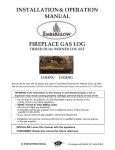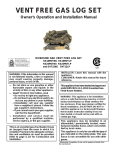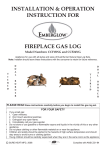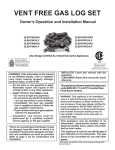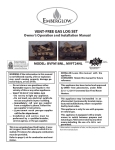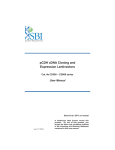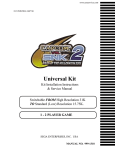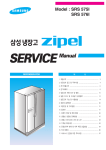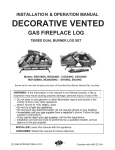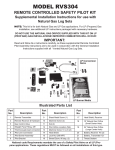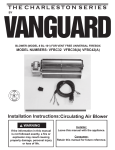Download Emberglow VMO24RNGA Installation Guide
Transcript
Tested & Listed By VMO24RNGA Vented Decorative Appliances for installation in Solid Fuel Burning Fireplaces For Use with APPALACHIAN OAK LOGS REMOTE CONTROL GAS LOG VENTED DECORATIVE APPLIANCE Convertible from Natural Gas to Propane/LP Gas OWNER'S OPERATION AND INSTALLATION MANUAL WARNING: If the information in this manual is not followed exactly, a fire or explosion may result causing property damage, personal injury or loss of life. — Do not store or use gasoline or other flammable vapors and liquids in the vicinity of this or any other appliance. — WHAT TO DO IF YOU SMELL GAS • Do not try to light any appliance. • Do not touch any electrical switch; do not use any phone in your building. • Immediately call your gas supplier from a neighbor’s phone. Follow the gas supplier’s instructions. • If you cannot reach your gas supplier, call the fire department. — Installation and service must be performed by a qualified installer, service agency or the gas supplier. INSTALLER: Leave this manual with the appliance. CONSUMER: Retain this manual for future reference. Safety ............................................................... 2-3 Product Identification ........................................... 3 Local Codes .........................................................4 Unpacking ............................................................4 Product Features ................................................. 4 Installation ............................ ........................ 4-10 .............. 11 Operation .. ........................................................ Inspecting Burners ............................................ 12 Cleaning and Maintenance ................................13 Service Hints .....................................................13 Technical Service ...............................................13 Troubleshooting ...........................................13-14 Replacement Parts ......................................15-16 Warranty ............................................ Back Cover SAFETY WARNING: Improper installation, adjustment, alteration, service, or maintenance can cause injury or property damage. Refer to this manual for correct installation and operational procedures. For assistance or additional information consult a qualified installer, service agency, or the gas supplier. WARNING: This appliance is for installation only in a solid-fuel burning masonry or UL127 factory-built fireplace, constructed of noncombustible material, and connected to a working flue. (See page 5 for minimum flue opening.) WARNING: This is a gas-fired appliance. It uses air (oxygen) from the room in which it is installed. Provisions for adequate combustion and ventilation air must be provided. Refer to the National Fuel Gas Codes, ANSI Z233.1/NFPA54,Air for Combustion and Ventilation . WARNING: This product contains chemicals known to the State of California to cause cancer or birth defects, or other reproductive harm. WARNING: Keep flue open when operating unit. IMPORTANT: Read this owner’s manual carefully and completely before trying to assemble, operate, or service this log set. Improper use of this log set can cause serious injury or death from burns, fire, explosion, electrical shock, and carbon monoxide poisoning. DANGER: Carbon monoxide poisoning may lead to death! 2 Carbon Monoxide Poisoning:Early signs of carbon monoxide poisoning resemble the flu, with headaches, dizziness, or nausea. If you have these signs, the log set may not be working properly. Get fresh air at once! Have log set serviced. Some people are more affected by carbon monoxide than others. These include pregnant women, people with heart or lung disease or anemia, those under the influence of alcohol, and those at high altitudes. Natural and Propane/LP Gas: Natural and propane/LP gases are odorless. An odormaking agent is added to the gas. The odor helps you detect a gas leak. However, the odor added to the gas can fade. Gas may be present even though no odor exists. Make certain you read and understand all warnings. Keep this manual for reference. It is your guide to safe and proper operation of this log set. WARNING: Any change to this log set or its controls can be dangerous. 1. This appliance, as supplied, is only for use with the type of gas indicated on the rating plate. This appliance is convertible for use with propane/LP. (see Conversion Instruction, P.7 ) 2. What to do if you smell gas: • Shut off gas supply. • Do not try to light any appliance. • Do not touch any electrical switch; do not use any phone in your building. • Immediately call your gas supplier from a neighbor’s phone. Follow the gas supplier’s instructions. • If you cannot reach your gas supplier, call the fire department. 3. Never install the log set: • In a recreational vehicle • Where curtains, furniture, clothing, or other flammable objects are less than 42" from the front, top, or sides o f t he log se t • In high traffic area • In windy or drafty areas SAFETY Continued 5. You must operate this log set with fireplace screens in place and fully closed. Unless provided by other means, fireplace doors or screens shall haveopenings for introduction of combustion air. 11. Do not run log set: • where combustible materials, gasoline and other flammable vapors and liquids are used or stored • under dusty conditions 6. This log set is designed to be smokeless. If logs ever appear to smoke, turn off appliance and call a qualified service person. Note: During initial operation, slight smoking could occur due to log curing and the burning off of manufacturing residues. You may wish to add more ventilation by opening a window. 7. To reduce the creation of soot,, follow the “Cleaning and Maintenance” instructions on page 13. 12. Do not burn solid fuel in the fireplace after installing the log set. Do not use this log set to cook food or burn paper or other objects. 13. Log set becomes very hot when in use. Keep children and adults away from hot surface to avoid burns or clothing ignition. Log set will remain hot for a time after shut-down. Allow surface to cool before touching. 14. Carefully supervise young children when they are in the room with log set. 8. Do not allow fans to blow directly into the fireplace. Avoid any drafts that alter burner flame patterns. Ceiling fans can create drafts that alter burner flame patterns. Altered burner patterns can increase sooting. 9. Do not use a blower insert, heat -exchanger insert or other accessory not approved for use with this log set. 10. The installation and provisions for combustion and ventilation air must conform with the National Fuel Gas Codes, ANSI Z233.1/NFPA 54, Air for Combustion and Ventilation. 15. Do not use this appliance if any part has been under water. Immediately call a qualified service technician to inspect the appliance and to replace any part of the control system and any gas control which has been under water. 16. To help prevent breakage, new logs must be broken-in (see “Curing Logs” page 12). 17. Turn log set off and let cool before servicing, installing, or repairing. Only a qualified service person should install, service, or repair log set. 18. Provide adequate clearances around air openings. PRODUCT IDENTIFICATION Heat Shield Burner Tube Burner Pan Control Knob Figure 1 - Product Identification - VMO24RNGA Shown 3 UNPACKING LOCAL CODES Install and use log set with care. Follow all local codes. In the absence of local codes, use the latest edition of The National Fuel Gas Code ANSIZ223.1/NFPA 54*. CAUTION: Do not remove the metal data plates from the burner pan. The data plates contain important warranty and safety information. . *Available from: American National Standards Institute, Inc. 1430 Broadway New York, NY 10018 National Fire Protection Association, Inc. Batterymarch Park Quincy, MA 02269 1. Remove logs, hearth kit, pan materials, and hardware from carton. 2. Remove all protective packaging applied to logs and base for shipment. 3. Check appliance for any shipping damage. If it is damaged call Sure Heat Manufacturing at 1-800-229-5647 for replacement parts before returning to dealer. PRODUCT FEATURES REMOTE CONTROL SAFETY VALVE/PILOT This unit is provided with a remote gas control valve which is connected to a wireless transmitter/receiver set, allowing safe operation from anywhere in the room. APPROVALS Unit is tested and approved to ANSI Z21.60 as a vented decorative appliance. It is supplied with the parts and instructions to convert to propane/LP gas use. INSTALLATION WARNING: The Massachusetts State Board requires all installations be performed by a Licensed Plumber or Gas Fitter. Massachusetts state code requires all vent dampers be welded open or removed. CAUTION: Do not remove the data plates attached to the burner pan. The data plates contain important warranty and safety informat- NOTICE: Installation, service, and repair of this appliance must be performed by a qualified installer, service agency, company or gas supplier, experienced with this type of gas appliance. Only factory authorized components should be used, in accordance with the manufacturer’s instructions and all codes and requirements of the authority having jurisdiction. Any modifications to this kit, or use of unauthorized components or accessory items will void the manufacturer’s warranty, and may result in a hazardous condition. ion. WARNING: Before installing in a solid fuel burning fireplace, the chimney flue and firebox must be cleaned of soot, creosote, ashes and loose paint by a qualified chimney cleaner. Creosote will ignite if highly heated. A dirty chim ney flue may create and distribute soot within the house. Inspect chimney flue for damage. VENTING SPECIFICATIONS FOR INSTALLATION The fireplace chimney flue and vent must be drafting properly. To check the vent for proper drafting: Light a tightly rolled newspaper on one end and place it at the inside front edge of the fireplace. Observe the smoke and be sure the vent is properly drawing it up the chimney. If the smoke spills out into the room, extinguish the flame and remove any obstruction until proper venting is achieved. 4 FLUE OPENING SPECIFICATIONS Note: This vented appliance must be installed only in a solid-fuel burning fireplace with a working flue and constructed of noncombustible material. The chimney flue damper must be fixed open to provide a minimum of 81 sq. in. of free air opening during operation of this log set. A multipurpose damper clamp is provided to fix the damper in position. The minimum flue sizes shown in Figure 2 are based on a 6' chimney height using round pipe. Your minimum flue size will vary based on input rate and chimney height. Refer to the National Fuel Gas Code ANSI Z223.1/NFPA 54, Section 6.6, for details. INSTALLATION Continued The charts in Figure 2 indicate technical information regarding the installation of your gas log set. Please make sure that all of the specifications shown are applicable before installation is attempted. The fireplace must include a working flue and venting system with the minimum openings shown in the Figure 2. LOG SIZE 24" MINIMUM FIREBOX SIZE FRONT BACK MINIMUM WIDTH WIDTH* DEPTH HEIGHT FLUE SIZE 8" dia. 35 3/4" 17" 15 1/2" 18" CHECK GAS TYPE Use only natural gas. If your gas supply is not natural gas, you must convert the appliance to propane /LP. Follow the instructions on page 7. If the fireplace does not have a gas supply shutoff valve, one must be installed. INSTALLING DAMPER CLAMP Secure the damper stop clamp provided to the leading edge of the damper as shown in Figure 3. If for any reason this clamp doesn't work on your fireplace, another suitable clamp or permanent stop must be installed, or the damper blade must be cut or removed. FUEL PRESSURE SPECIFICATIONS (W.C.) Inlet Manifold* NG 5.5"-10.5" 3.5" LP 11"-13" 10" * ± .2" DESCRIPTION 24" Dual Burner LOG SIZE 24” In. .144 Btu\Hr Input Natural Gas 60,000 Damper Clamp Damper Damper Clamp Btu\Hr Input Propane Gas 60,000 Damper Damper BURNER ORIFICE NATURAL PROPANE/LP Num. In. Num. #27 .089” #43 - Figure 2 - Technical Information Charts CONNECTING TO GAS SUPPLY WARNING: A qualified service person must connect log set to gas supply. Follow all local codes. Installation Items Needed Before installing log set, make sure you have the items listed below. • piping (check local codes) • sealant (resistant to propane/LP gas) • equipment shutoff valve • adjustable (crescent) wrench or pliers • sediment trap • tee joint • pipe wrench CAUTION: Use only new, black iron or steel pipe. Internally-tinned copper tubing may be used in certain areas. Check your local codes. Use pipe of 1/2" diameter or greater to allow proper gas volume to log set. If pipe is too small, undue loss of volume will occur. Masonry Fireplace Manufactured Fireplace Figure 3 - Attaching Damper Clamp CONNECTING TO GAS SUPPLY Continued Installation must include an equipment shutoff valve with "T" style handle, gas union and, for propane/LP gas only, a plugged 1/8" NPT pressure tap. Locate NPT tap within reach for test gauge hook up. NPT tap must be upstream from log appliance (see Figure 4). IMPORTANT: Install equipment shutoff valve in an accessible location. The equipment shutoff valve is for turning on or shutting off the gas to the appliance. Apply pipe joint sealant lightly to male NPT threads. This will prevent excess sealant from going into pipe. Excess sealant in pipe could result in a clogged burner injector. WARNING: Use pipe joint sealant that is resistant to liquid petroleum (LP) gas. 5 INSTALLATION Continued We recommend that you install a sediment trap in the supply line as shown in Figure 4. Locate sediment trap where it is within reach for cleaning. Install in piping system between fuel supply and heater. Locate sediment trap where trapped matter is not likely to freeze. A sediment trap traps moisture and contaminants. This keeps them from going into log set controls. If sediment trap is not installed or is installed wrong, log set may not run properly. CSA Design-Certified Equipment Shutoff Valve With 1/8" NPT Tap* From Gas Meter (5" W.C.** to 10.5" W.C. Pressure) Approved Flexible Gas Hose (no longer than 36" if required by local codes) 3" Minimum Tee Pipe Cap Joint Nipple 4. Check all joints of gas supply-piping system. Apply a noncorrosive leak detection fluid to all joints. Bubbles forming show a leak. 5. Correct all leaks at once. 6. Reconnect log set and equipment shutoff valve to gas supply. Check reconnected fittings for leaks. Test Pressures Equal To or Less Than 1/2 PSIG (3.5 kPa) 1. Close equipment shutoff valve (see Figure 5). 2. Pressurize supply piping system by either using compressed air or opening main gas valve located on or near gas meter. - to equip ment 3. Check all joints from gas meter shutoff valve (see Figure 5). Apply a noncorrosive leak detection fluid to all joints. Bubbles forming show a leak. 4. Correct all leaks at once. Equipment Shutoff Valve Sediment Trap Figure 4 - Gas Connection Gas Meter * Purchase the optional CSA design-certified equipment shutoff valve from your dealer. ** Minimum inlet pressure for purpose of input adjustment. CHECKING GAS CONNECTIONS WARNING: Test all gas piping and connections, internal and external to unit, for leaks after installing or servicing. Correct all leaks at once. WARNING: Never use an open flame to check for a leak. Apply a noncorrosive leak detection fluid to all joints. Bubbles forming show a leak. Correct all leaks at once. PRESSURE TESTING GAS SUPPLY PIPING S YSTEM Test Pressures In Excess Of 1/2 PSIG (3.5 kPa) 1. Disconnect log set and its individual equipment shutoff valve from gas supply piping system. 2. Cap off open end of gas pipe where equipment shutoff valve was connected. 3. Pressurize supply piping system by either using compressed air or opening main gas valve located on or near gas meter. 6 Figure 5 - Checking Gas Joints HEARTH PAN I NSTALLATION If using propane/LP gas, see Propane/LP Gas Conversion page 7 before installing hearth pan. 1. Place the burner pan assembly in the center of the fireplace floor. Make sure the front of pan faces forward. 2. Thread the gas supply fitting to the fire place gas supply pipe. Adjust to most convenient position. 3. Install the gas connector tube to the gas supply adapter. Carefully shape tube and attach to gas inlet fitting (see Figure 6). Be careful not to cause kinks in tube. 4. Test for leaks following instructions under Testing Burner for Leaks , page 8. INSTALLATION Continued 5. Retighten and adjust the location of the gas control as necessary. The gas control should be level, with the control knob to the front. Be sure to use the correct orifice for your appliance. The orifice kit included with this appliance contains an orifice installed in an air mixer fitting. 4. Using thread sealant (resistant to the action of propane/LP gas) on smaller end of fitting, screw the burner inlet fitting into outlet side of gas control. Tighten using a wrench. 5 . Rethread valve and fitting assembly into burner tube until fully threaded and level with burner pan. Reattach valve cover with two (2) screws. NATURAL GAS COMPONENTS Gas Control Valve Natural Gas Pilot Orifice Figure 6 - Installing Inlet Fitting and Gas Connector Tube (Heat Shield Removed for Clarity) SELECTING GAS TYPE This appliance can be used with Propane/LP gas or Natural Gas. It is shipped from the factory adjusted for use with Natural Gas. Main burners are equipped with fixed orifices, located at the inlet of the burner pan (see Figure 7). WARNING: Only a qualified installer or service technician can perform gas conversion and connection to gas supply. Propane/LP Gas Conversion To convert to Propane/LP gas, the regulator press ure must be reset. Also, burner inlet fitting and pilot orifice must be replaced. The Propane/ LP burner inlet fitting is supplied with the orifice installed for your log set. Burner Inlet Fitting 1. Remove pilot assembly burner pan by removing two screws on bracket. 2. Unthread control valve and burner inlet fitting from burner tube by turning valve counterclock wise (see Figure 7) . 3. Remove Natural Gas inlet fitting from control valve assembly (see Figure 8). DO NOT remove orifice from this fitting. The Propane/LP burner inlet fitting is provided in the hardware kit (see Figure 8). Retain the removed Natural Gas components for future use. Burner Inlet Fitting for Natural Gas Figure 7 - Burner Inlet Fitting and Pilot Prifice Orifice for Natural Gas Injector for Propane/LP Gas NATURAL GAS FITTING PROPANE/LP GAS FITTING Figure 8 - Burner Inlet Fittings shown with orifice Pilot Orifice Replacement Disconnect the pilot supply tube from the pilot (See Figure 7). Replace the pilot orifice with the Propane/LP pilot orifice included with the Gas conversion kit. Retain the removed orifice for future use. NG to LP Regulator Selection The appliance regulator can be converted from Natural Gas to LP/gas. If connecting to a Propane gas system, the regulator must be switched prior to use. Follow the steps below to select Propane/LP gas. 1. Carefully remove the logs from the burner assembly. 2. Make sure gas is turned off to the unit and disconnect burner assembly from gas line. Remove burner assembly from fireplace or firebox. 3. Locate the regulator cap on the appliance regulator (see Figure 9). Unscrew by hand and remove the cap from the regulator. The pressure selecting screw is attached to the regulator cap. The pressure selecting screw is supplied in the Natural Gas position. 4. Unscrew and remove the pressure selecting screw from the regulator cap (see Figure 9 ). 7 INSTALLATION Continued 5. Turn pressure selecting screw over and reinstall it in regulator cap (see Figure 10-11).This will set the pressure selecting screw to the LP/Propane gas ition. Makethe pressure selecting screw is installed tightly to the regulator cap. 6. Replace the regulator cap on the appliance regulator. Figure 10 - Removing Regulator Cap from Pressure Selecting Screw Pressure Selecting Screw Appliance Regulator Regulator Cap Figure 9 - Gas Selection Valve Knob and Regulator Cap Figure 11 - Turning Pressure Selecting Screw Over/ Attaching to Regulator Cap – LP/Propane Gas Position NOTE: In order to convert the unit from LP Gas, back to Natural Gas, follow steps 1 through 3 under “Burner Inlet Fitting” on page 7.Follow steps 1 through 6 under the heading of “NG to LP Regulator Selection” on this page. Images 11 and 12 will occur in reverse order. Testing Burner for Leaks 1. Generously apply soapy solution to all connections. WARNING: Never check for gas leaks with open flame. 2. Light burner with shutoff valve no more than half open and holding a match slightly in front of pan (see Lighting Instructions , page 11). 3. Inspect all connections for bubbles, raw gas odor, or flame from any area other than the burner (leaks). If leaks are detected, shut off gas valve immediately. tighten, or reassemble loose connection(s) using pipe joint compound until burner system is leak free. 4. When burner is tested and leak free, observe individual tongues of flame on burner (from ports). Note: Make sure that all ports are clear and producing flame evenly across burner. If any ports appear blocked, clear them by removing burner manifold and 8 - reaming ports with a modified paper clip or other suitable tool. When finished testing, turn gas shutoff valve to OFF to extinguish all flames. Adding Burner Media Material 1. Open bag of burner media material (vermiculite if set for LP/Propane) and spread it evenly across burner pan to the top. You may overflow front and sides of pan to cover entire pan. Do not cover valve. 2. Open glowing embers and evenly cover burner media material (or vermiculite) in burner pan. Installing Grate and logs 1. Slide two rear log grate steps over two outer horizontal supports on t h e grate as shown in image 2 on page 9. 2. Install logs onto the grate by following the rest of the instructions in on pages 9 and10. LOG PLACEMENT VMO24RNGA 1 8 2 9 10 4 6 7 3 5 Log Identification Back Log Stand-Offs in place 2 1 Place main front log (1) onto front area of the grate Place shorter back log (2) onto raised area of the grate 4 3 Place Cross-Log (3) at the left side Place Cross-Log (4) at the center right 5 6 Place Cross-Log (5) atop (3) and (4) at the back left Place Cross-Log (6) atop (3) and (1) on the left side front. 9 LOG PLACEMENT VMO24RNGA Continued 7 Place Cross-Log (7) at the top back, on the right side 9 8 Place Cross-Log (8) atop (1) and (7) at the center right 10 Place smallest decorative logs (9) and (10) onto the fireplace floor at each end of burner pan WARNING: Failure to position the parts in accordance with these diagrams or failure to use only parts specifically approved with this appliance may result in property damage or personal injury. 10 OPERATION FOR YOUR SAFETY READ BEFORE LIGHTING WARNING: Keep flue open when operating unit. WARNING: If you do not follow these instructions exactly, a fire or explosion may result causing property damage, personal injury or loss of life. A. This appliance has a pilot which must be lighted by hand. When lighting the pilot, follow these instructions exactly. B. BEFORE LIGHTING smell all around the appliance area for gas. Be sure to smell next to the floor because some gas is heavier than air and will settle on the floor. WHAT TO DO IF YOU SMELL GAS • Do not try to light any appliance. • Do not touch any electric switch; do not use any phone in your building. • Immediately call your gas supplier from a neighbor’s phone. Follow the gas supplier’s instructions. • If you cannot reach your gas supplier, call the fire department. Thermopile Pilot Figure 12 - Thermopile and Pilot 1. STOP! Read the safety information on the left side of this page. 2. Make sure equipment shutoff valve is fully open. 3. Press in and turn control knob clockwise to the OFF position. 4. Wait five (5) minutes to clear out any gas. Then smell for gas, including near the floor. If you smell gas, STOP! Follow “B” in the safety information, page 11. If you don’t smell gas, go to the next step. - counter clockwise 5. Press in and turn control knob to the PILOT position. Press in control knob for five (5) seconds (see Figure 13). Note: You may be running this log set for the first time after hooking up to gas supply. If so, the control knob may need to be pressed in for 30 seconds or more. This will allow air to bleed from the gas system. 6. With control knob pressed in, use a match or grill lighter to light pilot. Visually locate the pilot (see Figure 12) on the edge of the burner pan to look for flame.If needed, repete operation until the pilot lights. Control Knob ON PILOT C. Use only your hand to push in or turn the gas control knob. Never use tools. If the knob will not push in or turn by hand, don’t try to repair it, call a qualified service technician or gas supplier. Force or attempted repair may result in a fire or explosion. D. Do not use this appliance if any part has been under water. Immediately call a qualified service technician to inspect the appliance and to replace any part of the control system and any gas control which has been under water. LIGHTING INSTRUCTION Figure 13 - Control Knob Location 7. If the pilot will not stay lit after several tries, turn the gas control knob to "OFF" and call your service technician or gas supplier. 8. Keep control knob pressed in- for 30 seconds after lighting pilot. After 30 seconds, release •control knob. If control knob does not pop out when released, contact a qualified service person or gas supplier for repairs. Note: If pilot goes out, repeat steps 3 through 8. 11 LIGHTING INSTRUCTION Continued 9. Slightly push in and turn control- knob counterclockwise to the ON position. 10.To leave pilot lit and shut off burners only: to the PILOT Turn control knob clockwise position, or set selector switch in the OFF position. TO TURN OFF GAS TO APPLIANCE Shutting Off Appliance 1. Slightly push in and turn control knob clockwise to the OFF position. 2. Close equipment shutoff valve. CURING THE LOGS During the 2-3 hour appliance break-in period, you may detect an odor from the appliance as the various paints and compounds used in the manufacturing of this log set cure. This is a normal and temporary situation that is not cause for alarm. However, you may want to provide extra ventilation to the room during this time. Hand Held Remote NOTICE: You must light the pilot before using the hand-held remote control unit. See Lighting Instructions, page 11. After lighting, let pilot flame burn for about one minute. Turn control knob to ON position. Slide the selector switch on the remote receiver to the REMOTE position. Note: The burner may light if hand-held remote was on when selector switch was last turned off. You can now turn the burner on and off with the handheld remote control unit. IMPORTANT: Do not leave the selector switch in the REMOTE or ON position when the pilot is not lit. This will drain the battery. INSPECTING BURNERS Check pilot flame pattern and burner flame patterns often. Pilot Adjustment Screw PILOT FLAME The pilot assembly is factory preset for the proper flame height. Alterations may have occurred during shipping and handling. The pilot is located on the back right hand side of the burner. The thermocouple should be fully enveloped in the flame. The flame should not be lifting off of the thermocouple element. If your pilot assembly does not meet these requirements: • Turn the adjustment screw marked pilot clockwise to decrease or counterclockwise to increase the flame to proper size (see Figure 14). Do not attempt to remove the adjustment screw. • SeeTroubleshooting, pages 13-14 Figure 14 - Locating Pilot Adjustment Screw BURNER FLAME PATTERN Burner flames will be steady; not lifting or floating. Flames should go up through the middle of logset. Flames should not "spill" to the edges of the pan or sides of the logset. Figure 15 shows a typical flame pattern. If burner flame pattern differs from that described: • Turn appliance off (see To Turn Off Gas to Appliance, this page). • See Troubleshooting , page14. Thermocouple Pilot Figure 13 - Correct Pilot Flame Pattern 12 Figure 15 - Typical Flame Pattern CLEANING AND MAINTENANCE • Keep the area around the log set clean and clear of debris. • Occasionally, you may use a soft bristle brush to clean logs. • Periodically inspect the air mixer and burner tube for foreign matter blocking the air inlet and flame holes. • Once every year a qualified agency or certified chimney sweep should examine and clean the venting system of the fireplace. SERVICE HINTS When Gas Pressure is Too Low • pilot will not stay lit • burners will have delayed ignition • heater will not produce specified heat • propane/LP gas supply may be low If you suspect your gas pressure is too low, contact your gas providerer and request that it be tested. TECHNICAL SERVICE For operational questions or technical service, call toll free (800) 229-5647. Be sure to have your model number availible when calling. TROUBLESHOOTING WARNING: Turn off log set and let cool before servicing. Only a qualified service person should service and repair log set. OBSERVED PROBLEM When attempting to ignite with a match,pilot will not light. POSSIBLE CAUSE 1. Gas supply turned off or equipment shutoff valve closed. 2. Control knob not in PILOT position. 3. Control knob not pressed in while in PILOT position. 4. Air in gas lines when installed. 5. Pilot adjustment screw closed. 6. Pilot is clogged. 7. Low/incorrect gas pressure. Pilot lights but flame goes out when control knob is released. 1.Control knob not fully pressed in. 2.Control knob not pressed in long enough. 3.Equipment shutoff valve not fully open. 4.Pilot flame not touching thermocouple, which al lows thermocouple to cool, causing pilot flame to go out. This problem could be caused by one or both of the following: A) Low gas pressure B) Dirty or partially clogged pilot 5.Thermocouple connection loose at control valve. 6.Thermocouple damaged. 7.Control valve damaged. Burner does not light after pilot is lit. 1.Burner orifice clogged. 2.Inlet gas pressure is too low. 3.Thermocouple leads dis connected or improperly connected. REMEDY 1.Turn on gas supply or open equipment shutoff valve. 2.Turn control knob to PILOT position. 3.Press in control knob while in PILOT position. - con 4.Continue holding down trol knob. Repeat igniting op eration until air is removed. 5.Adjust pilot flame for ap proximately 2" blue flame. 6.Clean pilot (see Cleaning and Maintenance, above) or replace pilot assembly. 7.Check/replace gas regulator. 1.Press in control knob fully. 2.After pilot lights, keep - con trol knob pressed in 30 seconds. 3.Fully open equipment - shut off valve. 4.A) Contact local natural gas company. B) Clean pilot (see Cleaning and Maintenance, above) or replace pilot assembly. 5.Hand tighten until snug, then tighten 1/4 turn more. 6.Replace thermocouple. 7.Replace control valve. 1.Clean burner orifice. 2.Contact local natural or propane/LP gas company. 3.Reconnect leads. 13 TROUBLESHOOTING OBSERVED PROBLEM Delayed ignition burner. Continued POSSIBLE CAUSE 1.Pilot flame needs adjust ing. 2.Wrong pilot orifice for gas type. Remote does not function. Battery is not installed. Battery power may be low. Burner flame is too low or too high. 1. Incorrect gas supply or pressure. 2. Blocked burner orifice or burner manifold ports. 3. Improper burner orifice size. REMEDY 1. Adjust pilot flame for ap proximately 2" blue flame. 2. Replace pilot orifice. Replace 9-volt batteries in receiver and/or remote control. 1.Check for proper gas supply pressure. 2.Free burner orifice and manifold ports of any burrs, paint, or other blockage. 3.Verify proper burner orifice sizing (see Figure 2, page 5). Burner is excessively noisy. (Note: The movement and combustion of gas will cre ate low, unavoidable levels of noise.) 1.Passage of air/gas across irregular surfaces. 2.Excessive gas pressure on natural gas units. 1.Relieve any tight bends or kinks in gas supply line. 2.Have inlet gas pressure checked by a qualified ser vice person. Log set is smoking/sooting excessively. (Note: It is natural and unavoidable for vented gas log sets to produce moderate levels of carbon (soot) where flames contact the logs. This is especially true with propane/ LP gas.) 1.Poor fuel quality. 1. Contact local natural or propane/LP gas company. 2. Adjust damper wide open and/or have fireplace and venting professionally cleaned and checked. 3. Separate the logs to allow more flame passage. 4. Remove any foreign items from the flame pattern and/ or check for proper orifice sizing. 5. Preheat flue in very cold weather. 2.Fireplace venting system not drafting properly. 3. Excessive flame impingement or blockage. 4. Improper fuel/air mixture. 5. Excessive gas supply/pressure. Log set produces a clicking/ ticking noise just after burner is lit or shut off. Metal expanding while heating or contracting while cooling. This is normal with most log sets. If noise is excessive, contact qualified service person. Log set produces unwanted odors. 1. Log Set burning vapors from paint, hair spray, glues, cleaners, chemicals, new carpet, etc. (See IMPOR TANT statement below.) 2. Gas leak. See Warning statement below. 1. Open flue to maximum. Stop using odor causing products while log set is running. Gas odor even when control knob is in OFF position. 1. Gas leak.See Warning statement below. 2. Control valve defective. • • • • • 2. Locate and correct all leaks (see Checking Gas Connections, page 6). 1. Locate and correct all leaks (see Checking Gas Connec tions, page 6). 2. Replace control valve. WARNING: If you smell gas: Shut off gas supply. Do not try to light any appliance. Do not touch any electrical switch; do not use any phone in your building. Immediately call your gas supplier from a neighbor’s phone. Follow the gas supplier’s instructions. If you cannot reach your gas supplier, call the fire department. IMPORTANT: Operating log set where impurities in air exist may create odors. Cleaning supplies, paint, paint remover, cigarette smoke, cements and glues, new carpet or textiles, etc. create fumes. These fumes may mix with combustion air and create odors. These odors will disappear over time. 14 VMO24RNG(LP)A PARTS 22 21 24 2 19 23 18 20 19 7 1 27 6 28 5 4 16 LP Conversion 3 L 8 15 17 9 25 14 11 13 12 10 26 28 15 VMO24RNG(LP)A PARTS Continued KEY NO. DESCRIPTION QTY. 1. SBNCJ00365A Burner Pan 1 2. RCOCB00002A Burner Tube 1 3. RMH-120-00085B Orifice Holder, Natural Gas 1 4. RMH-120-90955 Orifice, Natural Gas 1 5. RMH-120-00084B Orifice, Propane/LP Gas 1 6. RMH-120-00324 Orifice, Propane/LP Gas 1 7. RCODZ00145A Washer 1 8. RMH-120-00574 Pal Nut 1 9. RMH-120-00069 Elbow, “Street” 3/8”NPT 2 10. RMH-120-AF1010 Valve, Remote “ON/OFF” 1 11. RMH-120-RVS304 Heat Shield 1 12. RMH-120-90860 Pipe, “Close” 3/8” NPT 1 13. RCOZZ00568A Regulator, Dual Fuel 1 14. RMH-120-00050 Fitting, 3/8” NPT X 3/8” Flare 1 15. KHH-ACT16 Connector, 3/8” Tube 1 16. FCHD1809021 Fitting, 3/8” X 1/2” NPT Female 1 17. RMH-120-00571 Screw #6 32 x 1/2” 1 18. RCOZZ00495B Pilot Assembly, NG 1 19. RMH-120-00570 Screw, Sheet Metal #6 x 1/2” 3 20. RMH-120-PBAGA Pilot Bracket 1 21. RCORJ00003A Grate, Vented 1 22. SPSCJ00106A Standoff, Back Log 2 23. RMH-120-00420 Burner Spacer 1 24. RMH-120-00100 Damper Clamp 1 25. RCAF-1001 Remote Set (Transmitter and Receiver) 1 26. RS1A Heat Shield, Receiver 1 27. RMH-130-00310 Vermiculite Granules (LP Media) 1 28. ACC16 Glowing Embers 1 WIP-130-00010 Burner Media, Natural Gas 1 Not Shown 16 PART NO. NOTES ______________________________________________________ ______________________________________________________ ______________________________________________________ ______________________________________________________ ______________________________________________________ ______________________________________________________ ______________________________________________________ ______________________________________________________ ______________________________________________________ ______________________________________________________ ______________________________________________________ ______________________________________________________ _____________________________________________________ ______________________________________________________ ______________________________________________________ ______________________________________________________ ______________________________________________________ ______________________________________________________ ______________________________________________________ ______________________________________________________ ______________________________________________________ ______________________________________________________ ______________________________________________________ ______________________________________________________ ______________________________________________________ _____________________________________________________ ______________________________________________________ ______________________________________________________ ______________________________________________________ ______________________________________________________ ______________________________________________________ ______________________________________________________ ______________________________________________________ ______________________________________________________ 17 NOTES: NOTES: LIMITED WARRANTY Sure Heat Mfg. warran ts that the components of this appliance are warranted free from defects in material and workmanship for one (1) year from the date of purchase. Sure Heat Mfg.at its option, will repair or replace this product or any component of the product found to be defective during the warranty period. Replacement will be made with a new manufactured product or component. If the product is no longer available, replacement may be made with a similar product of equal value.This warranty does not include transportation . or shipping costs of any kind. This is your exclusive warranty. This warranty is valid for the original retail purchaser from the date of initial retail purchase and is not transferable. Keep the original sales receipt. Proof of purchase is required to obtain warranty parts. This warranty does not cover normal wear of parts such as scratches and dents of the components or damage resulting from any of the following: • negligent use or misuse of the product, including exposing the product to chemicals or cleaning products not approved by Sure Heat Mfg. • corrosion, rust or discoloring of any kind • use or installation contrary to specified instructions and applicable building codes, including heating the product to temperatures above its rated specifi cations which can cause considerable warping disassembly, including removal of the product from a built-in installation • • damage resulting from accident, alteration, misuse, abuse, hostile environments, or improper installation • repair or alteration • acts of God, such as fire, flood, hurricanes, and tornadoes • gas cylinders,propane tanks or other fuel deliverysystems, including connections to a household fuel supply • usage other than single-family household use such as commercial or industrial use • minor warping or discoloration of parts, which is normal and not a defect under this warranty DO NOT RETURN THIS PRODUCT TO THE PLACE OF PURCHASE If the appliance does not operate properly , first thoroughly carry out the instructions provided with the unit to ensure that the appliance is installed correctly and check the troubleshooting section in this use and care manual. We recommend you return this warranty registration card so that you can be contacted should any questions of safety arise that could affect you. The return of the warranty registration card is not a condition for warranty coverage. Purchased From: _____________________________________ Date: ____________ Model: VMO24R(NG,LP)A Serial Number: ____________________ Name: ______________________________ Phone Number: ___________________ Address: _____________________________________________________________ City: _________________________________ State: ________ ZIP: _____________ Because of continuing product improvement, these specifications are subject to change without notice. If you have other questions or need replacement parts contact our Customer Service Hotline at (800) 229-5647 or visit our website at www.sureheat.com Sure Heat Manufacturing, 3140 Moon Station Road, Kennesaw GA, 30144 RMH-130-OMRCV Rev1.1 06-2014






















